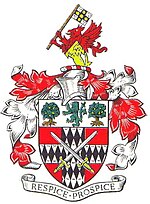Stoke Newington Metropolitan Borough Council
| Stoke Newington | |
|---|---|
 Stoke Newington Town Hall |
|
 Stoke Newington within the County of London |
|
| History | |
| • Origin | Stoke Newington parish |
| • Created | 1900 |
| • Abolished | 1965 |
| • Succeeded by | London Borough of Hackney |
| Status | Metropolitan borough |
| Government | Stoke Newington Borough Council |
| • HQ | Stoke Newington Church Street |
| • Motto | Respice Prospice {Look to the past and the future} |
 Coat of arms of the borough council |
|
The Metropolitan Borough of Stoke Newington was a metropolitan borough in the County of London between 1900 and 1965 when it became part of the London Borough of Hackney.
The borough was the successor to two local authorities: the vestry of Stoke Newington parish in the County of London and the South Hornsey Urban District Council in Middlesex.
Under the Metropolis Management Act 1855 Stoke Newington had been grouped with the neighbouring parish of Hackney under the administration of the Hackney District Board of Works. The union with Hackney was very unpopular with the inhabitants of Stoke Newington, and following unsuccessful attempts to end it in 1864, 1880 and 1890, the parish regained independence in 1894. Stoke Newington Vestry consisted of 60 vestrymen, elected from five wards.
South Hornsey formed the southern part of the parish of Hornsey, consisting of the Brownswood Park area south of Finsbury Park, 29 acres (0.1 km2) of Clissold Park and two detached areas entirely surrounded by the parish of Stoke Newington. The exclaves of South Hornsey effectively cut off the south-eastern section of Stoke Newington from the rest of the parish. A local board was formed to govern the area in 1867, becoming an urban district under the Local Government Act 1894.
The London Government Act 1899 provided that the County of London should be divided into metropolitan boroughs. The new authorities were to based on existing parishes with simplified boundaries. It was intended that each borough would have a population of between 100,000 and 400,000 inhabitants. Where an area fell below the threshold of 100,000 inhabitants, it might still be constituted a borough if it had a rateable value exceeding 500,000 pounds.
...
Wikipedia
